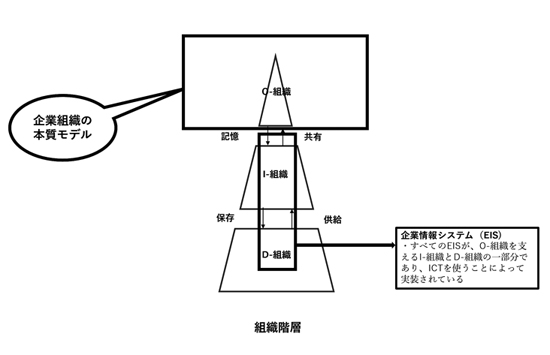11th draft “EE Organizational Essence Theory”” Hideya Inoue (Management Structure Analysis Consultant)


The EE Organizational Essence Theory defines the types of production actions brought about by transactors (a concept that combines transactions and their executors) that exist in the tree structure of organizational structure as being ‘original’, ‘informational’, and ‘documental’.
In this case, the conceptual organizations that share the production actions are called 0-organization (original organization), I-organization (informational organization), and D-organization (documental organization) respectively (the diagram shows the interactions between organizational hierarchies, but they exist separately from the tree structure described in the 10th draft).
Original production actions are all production actions that bring about new facts in the business world of a company, such as inventing things, making decisions and judgments, transporting, and observing, and are shared by 0-organization. The necessary execution capabilities are called ‘performers’ that correspond to the social world.
Informational production acts are storing facts, calculating and deriving, and sharing facts, and are shared by the I-organization. The necessary performance capabilities are called ‘informa’, which corresponds to semantics and pragmatics.
Documental production acts are storing/converting/providing documents or data, and storing/copying/transferring/destroying/retrieving files, and are shared by the D-organization. The necessary performance capabilities are called ‘forma’, which corresponds to syntax and empiricism.
Original acts are the only acts that change the state of the world, and at the same time, they are acts that create value that is directly connected to the raison d’être of the organization, so they are the very essence of the organization.
The ontological model (a constructive model abstracted from the implementation) of a company’s 0-organization is called the essential model. The volume of the essential model is less than 5% of all documents, reducing complexity and significantly improving intellectual manageability. The essence is simple and clear.
The diagram shows the relationship between the enterprise information system (EIS) and the essential model. The EIS handles information as a means according to a “communication-centered view.” In other words, the EIS is closely linked to the organizations it supports (the I-organization and the D-organization).
The EIS connects the 0-organization and the I-organization by storing and sharing, and connects the I-organization and the D-organization by storing and supplying. The EIS plays a key role in supporting the 0-organization, which is responsible for “production,” the essence of a company. Do not talk about the effectiveness of ICT for DX without understanding the hierarchical structure of production organizations.
※Translating Japanese articles into English with AI
